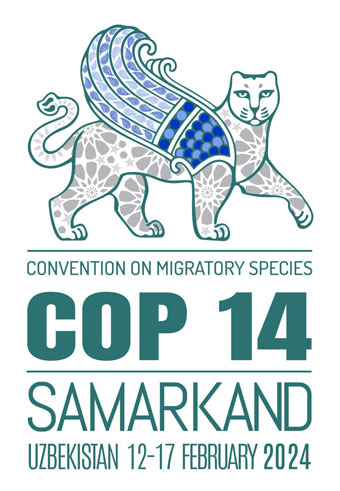
Convention on the Conservation of Migratory Species of Wild Animals COP 14 -- 12 to 17 February 2024
The 14th Meeting of the Conference of the Parties to the Convention on the Conservation of Migratory Species of Wild Animals (CMS COP14) is set to take place in the historic city of Samarkand, Uzbekistan, from 12 to 17 February 2024. The meeting will highlight the issues of:
- habitat conservation and restoration,
- threats to species such as overexploitation,
- habitat loss and fragmentation,
- pollution, and
- climate change
The conference will be convened under the slogan, "Nature knows no borders". This is a reminder that the journeys of migratory species do not adhere to political boundaries and that their survival is dependent on international collaboration and transboundary conservations efforts.
Excerpt from the statement by the Acting Executive Secretary of the Convention on Biological Diversity.
|
"The Kunming Montreal Global Biodiversity Framework provides an overall plan for action on biodiversity, including through CMS and other biodiversity related conventions. It is a hugely ambitious plan, aiming to Protect and Restore Nature, to Prosper with Nature, to Share Benefits Fairly and to Invest and Collaborate for Nature. While some of the 2030 action targets focus on species (in particular, targets 4, 5, and 9), all of the 23 targets are relevant to the CMS. Achievement of the goals and targets requires a whole-of-government and whole-of-society approach with the full engagement of indigenous peoples and local communities, women and youth as well as business and finance, among others. On the other hand, the Samarkand Strategic Plan on Migratory Species and decisions adopted at this CMS COP14 will support implementation of the Kunming Montreal Global Biodiversity Framework. The updating of national biodiversity strategies and action plans, currently being undertaken by Parties to the CBD as they align their national targets with the KMGBF, provides an important opportunity for the integration of activities under CMS and other biodiversity related conventions. The CBD Secretariat is committed to working closely with the CMS Secretariat to support the Parties of both instruments in achieving our common objectives and the goals and targets of the Kunming-Montreal Global Biodiversity Framework." |
|---|

More information:
World Migratory Bird Day - 2023
Biodiversity Plan targets particularly relevant to CMS
Ensure urgent management actions to halt human induced extinction of known threatened species and for the recovery and conservation of species, in particular threatened species, to significantly reduce extinction risk, as well as to maintain and restore the genetic diversity within and between populations of native, wild and domesticated species to maintain their adaptive potential, including through in situ and ex situ conservation and sustainable management practices, and effectively manage human-wildlife interactions to minimize human-wildlife conflict for coexistence.
Why is this target important?
Though some extinctions are the result of natural processes, human actions have greatly increased current extinction rates and risk. The global species extinction rate is at least tens to hundreds of times higher than the average over the past 10 million years, and the rate is increasing. About 1 million species are currently threatened with extinction. The global increase in extinction and extinction risk is also contributing to the decline of genetic diversity. Genetic diversity is critical for the long-term stability, adaptability and resilience of biodiversity, both at the species and ecosystem levels, and it supports the continued provision of nature’s contributions to people. Various species-specific management interventions will be needed to ensure the conservation of species.
Click here to read more about this and all 23 targets in the Biodiversity Plan
Ensure that the use, harvesting and trade of wild species is sustainable, safe and legal, preventing overexploitation, minimizing impacts on non-target species and ecosystems, and reducing the risk of pathogen spill-over, applying the ecosystem approach, while respecting and protecting customary sustainable use by indigenous peoples and local communities.
Why is this target important?
The direct exploitation of wild populations of species is the largest direct driver of biodiversity loss in marine ecosystems and the second largest in terrestrial and freshwater ecosystems. Actions to address the legality, sustainability and safety of the use of wild species of fauna and flora need to take place at the point of harvest, landing, during transportation and trade, and at point of final consumption – the latter affecting overall demand – are key to preventing biodiversity loss.
Click here to read more about this and all 23 targets in the Biodiversity Plan
Ensure that the management and use of wild species are sustainable, thereby providing social, economic and environmental benefits for people, especially those in vulnerable situations and those most dependent on biodiversity, including through sustainable biodiversity-based activities, products and services that enhance biodiversity, and protecting and encouraging customary sustainable use by indigenous peoples and local communities.
Why is this target important?
Biodiversity is the source of many goods and services on which people depend. The maintenance, in quantity and quality, of the benefits provided by biodiversity offers an important incentive for the conservation and sustainable use of biodiversity. It will not be possible to reach the 2050 Vision if the benefits provided by biodiversity, particularly those related to nutrition, food security, livelihoods, health and well-being, are not ensured.
Click here to read more about this and all 23 targets in the Biodiversity Plan